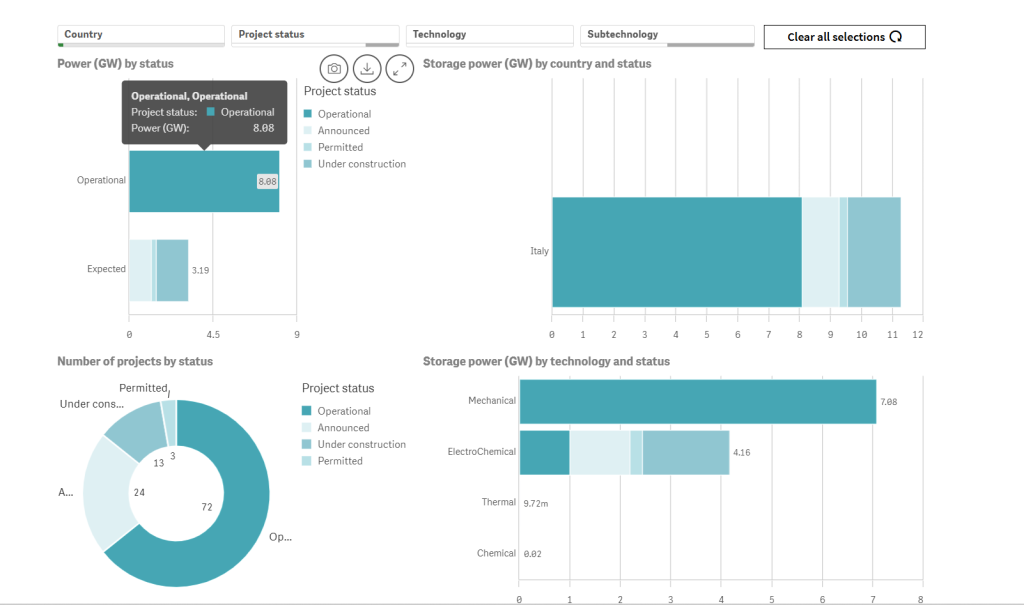The Autorità di Regolazione per Energia Reti e Ambiente (ARERA) has set the maximum award for the first auction of the Term Supply Market for Electric Storage Capacity (MACSE) at €32,000/MWh/year. This financial incentive seeks to ensure the financial viability of storage projects, especially those based on battery technologies.
The auction, scheduled for September 30, 2025, is part of Italy’s strategy to strengthen the flexibility of the electricity system and facilitate greater integration of renewable sources. ARERA specifies that “the figure defined responds to the CONE calculation, considering investment and operating costs, and a competitive WACC rate.”
A regulatory framework designed to optimize storage
The regulatory context of the MACSE arises from Article 18 of Legislative Decree 210/2021, which establishes a transparent and non-discriminatory auction system managed by Terna. The objective is clear: to minimize costs for end users and encourage the incorporation of new storage capacity under technologically neutral criteria.
“The Discipline provides for auctions to be structured based on geographic needs and storage type,” ARERA states. Furthermore, it will ensure that the awarded capacity is available to third parties in the energy and ancillary services markets.
Technological Evolution and Cost Reduction in Batteries
One of the key elements in determining the top prize was the update of the technical study on storage technologies, which reflects the evolution of lithium-ion battery costs. According to ARERA, “capital costs (CAPEX) for 4-hour systems range between €191,000 and €282,000/MWh.”
It also highlights that the useful life of these systems is between 15 and 20 years, with a full-cycle efficiency of 80-90%. The Authority points out that “a 12% oversizing is necessary to compensate for annual battery wear and tear and ensure contractual availability.”
Italy exceeds 8 GW of operational storage
In this scenario, Italy is already showing significant progress in installed capacity. According to data from the European Commission’s JRC Real-time Energy Storage, the country has 8.08 GW of operational energy and plans to add an additional 3.19 GW, including announced projects, projects under construction, and projects in the permitting phase.
Currently, mechanical technologies predominate, accounting for 7.08 GW, while electrochemical storage, which includes batteries, accounts for 4.16 GW. In total, there are 72 operational projects, complemented by 40 initiatives at various stages of development.

Outlook to 2028: Flexibility and Energy Security
The first MACSE auction contemplates the allocation of capacity with a delivery horizon in 2028, aligned with the goals of the National Integrated Energy and Climate Plan (PNIEC). ARERA emphasizes that “the definition of the maximum award seeks to balance competitiveness with the financial sustainability of the projects.”
The indicative WACC (rate of return on capital) is estimated at 8.1% nominal before taxes, although it will be confirmed at least 60 days before the auction. Furthermore, the fixed operating cost (CFO) will be set at around 2% of CAPEX.
With this scheme, Italy aims to consolidate a robust storage market, capable of supporting the growing penetration of renewable energy and ensuring the stability of the electricity system. “The flexibility that storage provides is essential for the energy transition,” ARERA emphasizes in its consultation document.
The implementation of MACSE not only represents an economic incentive but also a clear signal of Italy’s strategy to lead energy storage infrastructure in Europe. With more than 11 GW of operational and projected capacity, the country is positioned as a benchmark in the efficient management of renewable resources.
Below the official document of ARERA:
168-2025-R-eel






























